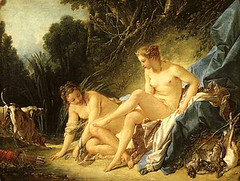ART/ART/ART My own paintings and those of artists I admire.Also some how-to-do-it posts about landscape painting.
Saturday 29 August 2009
the iraqi picasso
The painting, originating in Iraq, was not painted by Picasso. It is not of museum quality and probably dates from around 1900 . The pose is derived from a painting by Boucher in the Louvre-Diana leaving the Bath. This would be obvious to any first year art-history student.
Tuesday 25 August 2009
The majority is often wrong
The English language changes through ignorance, there is no doubt about it and I am sure this is not an original observation. One corruption or transformation which has been going on for the last two years at least is in the misuse of the the word majority. This is a word which in its usual use refers to number. We now see it by extension being used to describe the greater part of an object as in, "the majority of the South Front...." in material on display during the restoration at Stowe. This grates on my ear . Journalists are using it in this ignorant way. Here is an example from Oliver James," The great majority of depression is not major but what is known as minor....." So where was the sub-editor?
(September 3, 2009: I have an earlier example of the casual use of the word "majority". W Homer, in his 1964 study of Seurat writes of colours "which occupy the majority of the water area."(page 68).
Friday 7 August 2009
Palmer forged

This illustration shows a gross forgery of a Shoreham period work by Samuel Palmer. It was made by Keating and appeared with two others in the catalogue of an exhibition presented by a prestigious London gallery in 1970. The forgeries were accompanied by quality works by English watercolourists. The gallery had no intention to deceive but was itself deceived. Once again the forger of the painting had provided a forged provenance for the works.A provenance is nothing more than a history of where and with whom the work has spent its time since its creation. This helps to give persuade the buyer that reputable, perhaps very reputable people, have been custodians of the work. Where the provenance is genuine one can learn something about the history of collecting.
This forgery was the work of prolific but incompetent British forger, now dead.His action was despicable. No, I dont have much sympathy for dealers and art historians, and anyone can make a mistake. In this case some doubts were raised early on.
What concerns me is that the forger is a traitor to any sense of solidarity which might exist among artists. He-and it is usually a he, knows that his forgery is not in the same league as the work on which he parasitises. The forger is usually found out eventually but meanwhile he smears the reputation of a fellow artist. Compare the fake Palmer with the real thing and you can see how crude the forgery is. It may be argued that this Palmer forgery is in the style of the artist, but it is only a crude approximation. It is a garish travesty of an artistic moment when a burgeoning sensibility (Palmer's) made a creative leap such as our forger could never have manifested.
Monday 3 August 2009
Alan Sorell's Archaeological Illustrations

Not long ago my local Oxfam yielded up a copy of Alan Sorrell: Early Wales Re-Created which was published in 1980 by the National Museum of Wales. The name of Alan Sorrell is certainly well known to anyone over the age of fifty who has more than a passing interest in British archaeology; for it was he who was the illustrator of choice for all those Ministry of Works guidebooks which my generation brought home from visits to ancient sites. Sorrell's dramatic images showed high quality reconstructions of places as they might have looked during the time when they were inhabited. When I was young I did not appreciate these drawings but I have a different opinion now.
When I studied the book I found a postcard inserted beside Sorrell's drawing of the Roman villa at Llantwit Major.It showed another artist's reconstruction of the same site. What a contrast! Perhaps the previous owner had thought so too. Sorrell's drawing is richness itself compared to the work of the unnamed postcardist. He adopts a very high viewpoint so that you see over the villa and the surrounding countryside; lines of vision shoot off into the far distance-to vanishing points outside the image itself. High viewpoints are common with Sorrell: he deploys his perspective with panache-and of course he came from a period when art students were likely to learn it in a serious manner. His drawing is filled with incident: humans, animals and nature enrich the scene . The miserable art of the postcardist is timidity personified when compared to that of Sorell who uses as all his painterly skills to produce a living work of art. Sometimes I have thought that his work looks a little harsh but just as often I remember that he had to explain what was happening and consider how work would look when reproduced. He was also a muralist and muralists look for clarity. I would say that since Sorrell there has been something of a decline in this type of work. The illustrated leaflet for the mesolithic house at Howick was a case in point. There the drawings were more akin to something from a very rudimentary comic.It is good to see that there is a website commemorating Sorrell here . His wife, Elizabeth Tanner was also an artist of quality. Both were fortunate to study at a time when the ability to draw was valued.
Subscribe to:
Posts (Atom)
